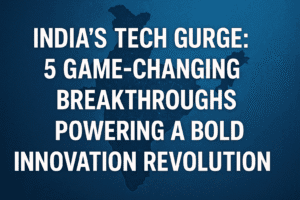India’s Tech Surge: 5 Game-Changing Breakthroughs Powering a Bold Innovation Revolution
India is decisively pivoting from a services powerhouse to a global leader in product-led deep-tech innovation. Spearheaded by institutions like C-DAC, SAMEER, and C-MET under MeitY, this shift focuses on “innovation with intent,” translating cutting-edge research in AI, quantum, 6G, and semiconductors into market-ready solutions solving real problems in healthcare, agriculture, and industry. Over 27 immediate industry collaborations, including product launches and tech transfers, validate this commercial focus.
Concurrently, advances like the new, advanced 5 GWh battery storage plant in Bengaluru showcase crucial progress in high-value manufacturing and energy independence. This integrated strategy – combining targeted R&D, public-private co-development, policy alignment (like Viksit Bharat 2047), and manufacturing muscle – builds a robust ecosystem. It moves beyond isolated projects to position India as a trusted source of secure, advanced solutions, capturing higher value globally while addressing domestic needs. This convergence marks a strategic repositioning with significant global implications.

India’s Tech Surge: 5 Game-Changing Breakthroughs Powering a Bold Innovation Revolution
The recent showcase of over 150 homegrown Indian technologies isn’t just another tech expo. It signals a profound and deliberate shift in the nation’s technological trajectory, moving decisively beyond services towards becoming a global powerhouse of product-led innovation driven by deep-tech research with tangible impact. Here’s what makes this development genuinely significant:
- From Labs to Markets: The “Innovation with Intent” Mandate: Gone are the days of isolated research silos. As MeitY Secretary S. Krishnan emphasized, this is “innovation with intent.” Institutions like C-DAC, SAMEER, and C-MET are no longer just publishing papers; they’re actively translating cutting-edge research in AI, quantum, 6G, semiconductors, medical electronics, and robotics into market-ready solutions. The immediate fruit? Over 27 concrete collaborations – product launches, tech transfers, MoUs – with industry leaders. Areas like sovereign cloud infrastructure, advanced LTCC packaging for electronics, and Industry 4.0 systems demonstrate a laser focus on solving real-world problems in healthcare, agriculture, telecom, and industry, backed by commercial validation from day one.
- Building an Ecosystem, Not Just Products: This isn’t a scattergun approach. The government, through MeitY, is strategically constructing a complete innovation ecosystem:
- Foundation: Investing in critical compute infrastructure and foundational models.
- Commercial Bridge: Actively facilitating partnerships between national labs, startups, academia, and established industry (evident in the 1000+ diverse attendees).
- Policy Alignment: Tightly integrating this push with the Viksit Bharat 2047 vision and the upcoming Anusandhan National Research Foundation (ANRF), ensuring long-term commitment and resource allocation.
Additional Secretary Amitesh Sinha’s call for private sector co-development in AI diagnostics, secure comms, and smart electronics underscores this collaborative ethos. The goal is a self-sustaining ecosystem where research feeds industry, industry provides real-world challenges and scale, and startups inject agility.
- The Manufacturing Muscle: Beyond Bits to Atoms: Complementing the digital thrust is a parallel, crucial advancement in hard tech manufacturing. The inauguration of the advanced 5 GWh Battery Energy Storage System (BESS) facility in Bengaluru is emblematic. It’s not just about storing energy; it’s about:
- Strategic Independence: Reducing reliance on imported energy storage tech.
- Enabling the Green Transition: Providing the essential grid stability needed for large-scale renewable integration.
- Tech-Forward Production: Showcasing high-precision, automated manufacturing capabilities (“cell-to-pack”). This facility represents the tangible “atoms” side of India’s tech ambition, proving the capacity to design and manufacture complex, high-value systems critical for the future.
- The Underlying Shift: Service Economy to Solution Provider: The most profound takeaway is India’s conscious evolution. Krishnan explicitly framed the R&D institutions’ role in moving “from a service-driven economy to a product-based innovation powerhouse.” This signifies:
- Capturing Higher Value: Moving up the value chain from executing others’ ideas to owning the intellectual property.
- Solving Domestic & Global Challenges: Developing technologies rooted in local needs (e.g., agriculture, healthcare diagnostics) but with inherent global applicability.
- Building Trusted Global Capacity: Positioning India not just as a market, but as a reliable source of advanced, secure technological solutions (“sovereign cloud,” secure comms).
The Real Insight: Convergence is Key
What truly sets this phase apart is the convergence:
- Research + Application: Labs are mandated with solving practical problems.
- Public + Private: Government institutions actively seek industry partnerships and co-development.
- Digital + Physical: Breakthroughs in AI/quantum are matched by advances in advanced manufacturing and materials science (like LTCC).
- Policy + Enterprise: Initiatives like viability gap funding for BESS align directly with industrial capability building.
The Value for Readers: Why This Matters Globally
This isn’t just an Indian story. It signals:
- A New Tech Partner: Global industries seeking cutting-edge, cost-effective solutions in deep-tech domains now have a rapidly maturing partner in India.
- A Blueprint for Development: India’s integrated approach – linking national strategy, research institutions, industry, and manufacturing – offers lessons for other ambitious economies.
- Accelerated Innovation: A massive pool of talent and a large domestic market focused on solving real problems will inevitably accelerate global innovation cycles in key sectors.
- Resilient Supply Chains: Advances in areas like semiconductor packaging and battery manufacturing contribute to diversifying global tech supply chains.
India’s tech ambitions are maturing beyond aspiration into a structured, ecosystem-driven reality focused on delivering solutions. The emphasis is on scale, speed, precision, and most importantly, impact. It’s a transition from participating in the global tech economy to actively shaping its next phase with made-in-India innovation. The world should take note; this is more than just progress, it’s a strategic repositioning.
You must be logged in to post a comment.